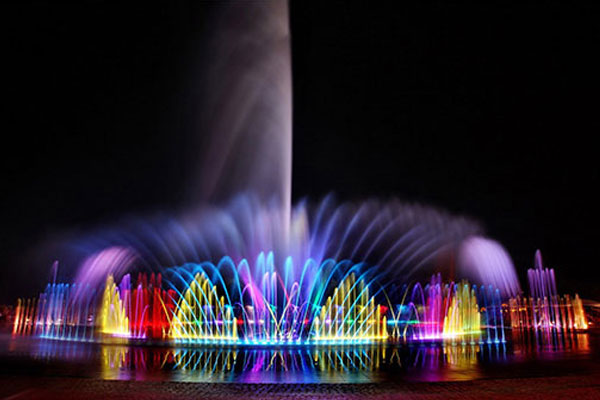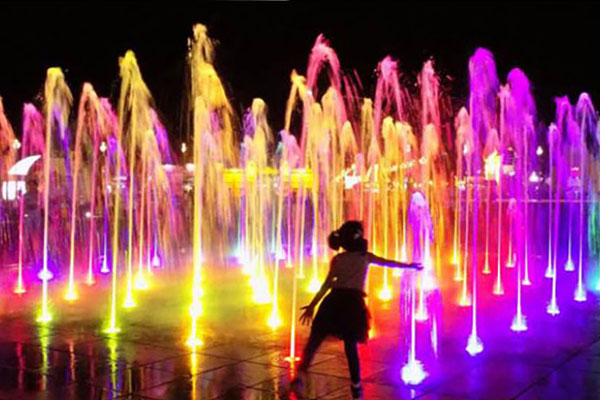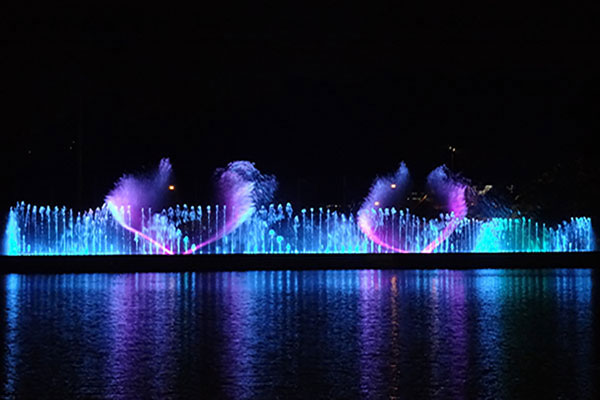20 Jun 2020
1. musical fountain water saving technology
During the operation of the fountain, various patterns are produced mainly by changing the shape of the water and combining the shapes of various waters to give people the enjoyment of beauty. Therefore, when the fountain is in operation, the primary energy saving is water resources. According to the current construction and development status of fountains in my country, combined with my many years of fountain construction and design experience, the author believes that water resources can be saved from the following aspects.
1) Fountain water circulation technology
At present, domestic fountains, whether they are pool fountains or dry land fountains, can basically realize the recycling of water. The main problems at present are: 1) The fountain water is not treated in the process of recycling. Unused water will inevitably have pollution problems when it is used repeatedly. Especially in dry spray, a large amount of pollutants on the ground will be recycled into the pool. If they are not treated, the contaminated fountain water will pose a threat to human health after contact with the human body. 2) The process of circulating fountain water is too simple, most of them are simply filtered, but not disinfected. Filtration treatment can only remove some suspended matter and floating matter, but it is difficult to eliminate pathogenic bacteria in the water, so the long-term use of fountain water will also cause adverse effects on human health. 3) The fountains used for a long time need to be replaced and refilled, which consumes a lot of water resources. If untreated water is used for a long time, after a period of time, the water in the fountain pool must be replaced or supplemented with fresh water. The larger the fountain, the higher the cost of replacing the water at one time, and some may even reach tens of thousands of yuan. At the same time, during the operation of the fountain, due to water evaporation, drift and other conditions, there will be a loss of water volume, and it is necessary to supplement the water tank from time to time. Therefore, adopting appropriate circulating water treatment technology can greatly reduce the number of water changes and replacements.
According to the author's experience, based on the principle of people-oriented and drawing on the relevant research experience [4], it is suggested that when the fountain water volume is less than 50m3, it can be directly replaced without treating the fountain water. When the water volume of the fountain is greater than 50m3, the fountain water needs to be recycled. Considering human health reasons, filtered water treatment equipment and disinfection treatment equipment must be added. Disinfection can use chemical agents, such as sodium hypochlorite, etc., and can also use electric sterilization And other methods.

2) Rainwater utilization technology
Since most fountains are built in public places such as parks and squares, there will inevitably be a large area of impermeable space around the fountain that can be used by tourists. These impervious grounds will produce a lot of rainwater when the rainfall reaches a certain intensity. If the rainwater can be collected, it can be used as a fountain to supplement water, on the other hand, it can also be used for greening of squares or parks, reducing waste of tap water and saving water resources. However, the following issues should be noted when using rainwater: The initial rainwater needs to be abandoned. According to research, many of the initial rainwater pollution indexes are equivalent to the general urban sewage, and some are even higher than the general urban sewage. Therefore, it is necessary to set up an abandonment device for the collected initial rainwater. According to related research [8], the author suggests that the initial rainwater abandonment flow can be controlled at about 5 mm, and only the later rainwater is collected for reuse. 2) Use rainwater to treat it. According to the provisions of the "Technical Regulations for Waterscape Fountain Engineering" of China Engineering Construction Standardization Association, the water used for fountains must meet certain water quality standards. The author suggests that you can refer to the "Technical Specification for Fountain Waterscape Engineering" to design the water quality treatment of the fountain.
3) Wind speed control fountain technology
Most large fountains are built outdoors. Therefore, during the use of the fountain, inevitably, due to evaporation, drift and other reasons, water loss will occur. Among them, the drift loss due to wind accounts for a large part of the loss. , The wind will also have a great impact on the pattern effect of the fountain [10]. Therefore, it is necessary to reasonably control the spray height of the fountain, or use related technologies to control the spray height of the fountain to reduce water loss. At present, large-scale fountains basically use frequency conversion control technology. Therefore, the author recommends using an anemometer to measure the wind speed at the location of the fountain, and convert the collected signals into pump control parameters through digital-analog conversion software to change The spray height of the fountain is high to reduce the water loss of the fountain.

2. Electrical energy-saving technology
1) Pump control technology
After years of development in my country, fountains have made great progress from the initial inability to automatically control fountains, to colored fountains, to program-controlled fountains, music fountains, and sound-controlled fountains. But from the fountain's power equipment, still rely on the water pump. Therefore, the energy saving during the operation of the fountain is mainly carried out through the control of the water pump. The author believes that the following aspects can be considered. 1) Selection of water pump. At present, the water pumps used in the fountain mainly include centrifugal pumps and submersible pumps. From the point of view of the performance and use of water pumps, the performance, efficiency and maintenance rate of centrifugal pumps are significantly lower than submersible pumps, but submersible pumps are far superior to centrifugal pumps in terms of flexibility. Therefore, there are many limitations in the use of centrifugal pumps. For example, a separate pump room is required. Although the head can be controlled by frequency conversion, it cannot be applied to fountains with various water types. Rockery fountains, waterfalls, and matrix fountains can be built. Use centrifugal pumps when uniform lift is required. Consider the use of submersible pumps in fountain designs such as limited by the site, or some fountains that require a single nozzle to change the head at any time. 2) Frequency conversion pump and industrial frequency pump. With the maturity of inverter technology, inverter pumps have been adopted by most large fountains. Compared with the power frequency pump, the frequency conversion pump is more efficient, the control is more free, and the fountain pattern is relatively rich. However, due to the relatively high price of inverter pumps, the initial construction cost is relatively high, but the later operating costs will be relatively low. The author recommends that when designing the fountain, consider using variable frequency pumps within the acceptable range of the investor.
2) Use of lanterns
The reason why the fountain is colorful is because of the use of its colored lights. A large-scale fountain can use thousands of colored lights. Therefore, colored lights are indispensable in the construction and use of modern fountains. The fountains in China used to be mostly ordinary underwater lanterns and underwater spotlights, whose power is generally 80W or more, but with the development of technology, LED lights, that is, light-emitting diodes are becoming more and more mature. More and more applications. LED It is a component made of semiconductor materials, which can convert electrical energy into light energy. It is not only small in size, but also resistant to vibration, low driving voltage, low power (3W-12W), less power consumption, less heat, switching speed Fast, long service life, changeable, high color purity, green and environmental protection. Compared with ordinary underwater lanterns, LED lights are more energy-efficient and more suitable for the development of modern fountains.
The design and operation of a fountain is a relatively complex process. In many actual fountain projects, only the basic selection of fountain nozzles, pipes, pumps, electrical equipment, etc., and the combined design of various types of fountains are often emphasized. Satisfying the basic functions of the fountain, but the design of the fountain's long-term operation and the environmental protection and energy saving of the fountain are often overlooked. This article briefly summarizes the possible energy-saving and environmental protection links in the design and operation of the fountain, and puts forward some energy-saving and environmental protection suggestions in the design and operation of the fountain, hoping to provide reference ideas for the construction of fountains in my country.
In the next passage, we will talking about floating pond fountain. As one of the most expressive waterscape forms, fountains are widely used in the construction of modern cities. The water body installed in the fountain can be divided into pools, reservoirs, lakes and rivers. The pool is built manually, and is generally equipped with overflow pipes and make-up pipes. The water level is basically kept constant, which is suitable for the installation of fixed fountains. However, the water levels of reservoirs, lakes, and rivers usually change, and it is difficult to control the water level manually. When the water level is too high during the flooding period to submerge the sprinkler or when the water level is too low during the dry season, the fountain cannot be performed. In recent years, several floating body installations for installing fountains have been developed. Fountain float refers to a steel body platform that can float on the water. Fountain equipment, such as submersible pumps, fountain pipes, regulating valves and spray heads, is installed on the platform. The position of the floating body platform can be adjusted according to changes in water level to meet the needs of the fountain show.

Keywords: musical fountain
Originally published 20 Jun 2020, updated 20 Jun 2020.